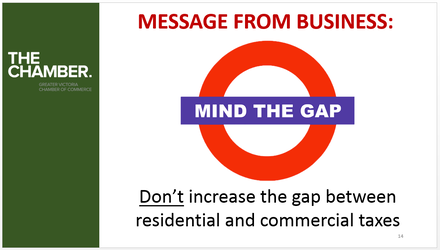 Victoria Mayor Lisa Helps, centre, tours Cenovus’ steam-assisted gravity drainage oilsands project at Foster Creek, Alta., April 26. Canada Action/Twitter Victoria Mayor Lisa Helps, centre, tours Cenovus’ steam-assisted gravity drainage oilsands project at Foster Creek, Alta., April 26. Canada Action/Twitter Local governments make decisions that directly impact our daily lives. From maintaining sidewalks in front of our homes and businesses, to setting property tax rates and making rezoning decisions that can profoundly affect the character of our neighbourhoods. It’s important work, though too often the tasks at hand don’t seem to be enough for some councillors. Take the widely publicized decision by Victoria Council to champion a lawsuit against the oil and gas industry. The idea was to have industry pay for costs attributed to climate change. This was an outsized overstep that played well to the choir but prompted everything from eye rolls to outright anger outside the echo chamber. At the Greater Victoria Chamber of Commerce, we expressed our concern with a letter to council asking them to rethink their decision. First and foremost, launching a lawsuit against industry is not a good use of city taxpayers’ money. Victoria council recently went through its first budget since last year’s civic elections. One third of council is brand new to the job, so we can understand their enthusiasm. But turning to legal action to try and fulfill your political mandate is not good leadership. Lawyers are expensive, and going through the courts is a time-consuming process that will, barring a miracle, take longer than council’s current term. All that, and the outcome is far from certain — in other jurisdictions, similar attempts at litigation have been dismissed. To her credit, Victoria Mayor Lisa Helps acknowledged as much even before the city’s resolution to consider litigation against fossil fuel companies was soundly struck down at the Association of Vancouver Island and Coastal Communities convention on April 14. Secondly, our region’s economy benefits from being a welcoming destination for all Canadians, including those from Alberta whose livelihood depends on revenue generated from the oil patch. Having a major source market threaten to boycott our region should give the city a pause — especially as they don’t speak for the residents of the other 12 municipalities that make up Greater Victoria. The thing is, Victoria has already identified a way forward. In the City’s Climate Leadership Plan, Mayor Helps states that her vision for Victoria will see us driven by amazing entrepreneurs who “leapt at the challenge to innovate and invent the goods and technologies needed for a clean-energy future.” The Chamber agrees that the answer lies in innovation led by business. We will continue to encourage all levels of government to focus on supporting the investments required to bring about the technological advances and societal uptake needed to become a low carbon society. Business wants to be part of the solution, and the best thing all levels of government can do is create the conditions that enable innovation. When it comes to climate change, we are all in this together. Catherine Holt is the CEO of the Greater Victoria Chamber of Commerce This column was originally published in the April 2019 edition of the Business Examiner
0 Comments
 What does it mean to be influential? At The Chamber, we recently rewrote our vision statement to set a goal of being “the most diverse and influential business association in the region.” For our board and staff, this means we are actively looking for members who reflect the diversity of our community — big and small businesses, established firms and start-ups, every industry and any sector. We want to connect with organizations led by people from many cultural backgrounds, any gender and all ages. If we’re diverse, we’re in a great position to be influential. However, I had a lightbulb moment while moderating a panel at the Inclusion Project, a conference held at Royal Roads University on March 30. The event is the brainchild of Ruth Mojeed, a recent grad from RRU’s Masters of Arts in Intercultural and International Communication, who arrived in Victoria from Nigeria in 2015. The goal is to start a dialogue that will result in a greater diversity of people included in the success of Greater Victoria. The room was packed with 170 people from an impressive array of backgrounds. Gender, race and age were the themes of the day and we had a very heartfelt and energetic conversation about improving inclusion. It struck me that, for many people, diversity does not translate into influence in the way we think of it at The Chamber. If you’re a newcomer to the community, or your definition of gender is outside the mainstream, or you’re seen as “too young” or “too old” you will too often feel the opposite of influence, which is powerlessness. To think of it another way, having influence is similar to having information. For some, that means holding it close so only you can wield it. You use information to have power over others. We see this in fields where acronyms and jargon are only understood by an inner circle — the military, engineering, accounting, IT, medicine and science come to mind. Information as a tool of exclusion. You need to be inside the echo chamber to know what’s going on. For others, information needs to be shared in order to have power over public opinion or political choices, or global trends, or just your friends and family and co-workers. Being seen as a source of beneficial information can be very powerful. It is the mindset of people, like me, who were trained as journalists. Information enables inclusion. Influence is kind of the same. You can claim to be influential because you are part of a small group that only talks among itself, and only helps each other make connections to those with the power to make decisions. Or you can be influential because you have a vast and varied network of connections. You always know someone who knows someone who knows whatever you need to find out or are trying to get to happen. And you can influence things through sheer numbers, volume of voices or impact of votes. The more people you know, and the more diverse those people are, the more influence you have. It seems blatantly obvious that influence by inclusion is a more rational approach than influence by exclusion. But that is not the lesson of history. I realized with concern, when The Chamber says it wants to be the most influential business association in the region, many people attending the Inclusion Project might take this to mean we are an old-style echo chamber for insiders. I was at the Inclusion Project to try to demonstrate the opposite. Our board and our membership is very clear that The Chamber works best when you walk into one of our events and feel a connection to like-minded people while also getting the sense you are about to expand your network and point of view by meeting someone different. As our Director of Operations says, The Chamber didn’t get to be 156 years old without changing with the times. Inclusion is the change happening now. By 2034, 100 per cent of population growth in Canada will be from immigration. Our top 10 source countries in Victoria in the last census period were the Philippines, China, U.S., U.K., India, South Korea, Mexico, Iran, Germany and South Africa. And we need them to fill the 150,000 job vacancies expected on Vancouver Island in the next 10 years — mostly due to retirements. Canada has a history of absorbing waves of immigrants under one big tent. Being inclusive is not without its challenges, but it will be our global strength if we manage it well while other countries struggle to insulate their echo chambers. The Chamber has a pretty diverse board and membership now. Of course, we can always do better. We want to be a big tent, too. Tell your friends. Catherine Holt is the CEO of the Greater Victoria Chamber of Commerce. This column was originally published in the Times Colonist on April 21, 2019.  Mind the gap. That was the message the Greater Victoria Chamber of Commerce presented to Victoria City Council earlier this year. Chamber Chair Dan Dagg and I went to the preliminary budget town hall to provide a voice for business. We wanted the newly elected councillors to know that businesses help create the vibrancy we love about Victoria. Businesses consist of people who provide employment and services and cannot be seen as an inexhaustible source of tax revenue. In 2019, rising commercial property values have added another variable to the role municipal councils have in setting property tax rates. The Chamber advocates for tax fairness and has been working to shine a light on the higher property tax rates all 13 Greater Victoria municipalities charge businesses compared to residents. Local governments set their annual budgets by determining how much they need to spend to deliver services to their citizens. After accounting for revenue from sources such as user fees, municipalities use property taxes to generate most of the cash needed to ensure they can balance their budgets. The two largest classes of properties are residential and business (commercial). Councils must balance the need to keep taxes affordable for citizens with the need to encourage investment and commercial development by not overburdening businesses. What The Chamber has noticed is a trend in recent years for municipalities to minimize increases to residents by offloading increasing costs to businesses. This was evident in rising tax multiples – for example, in 2016, Victoria charged businesses a tax rate that was 3.1 times the rate charged to residents. This multiple increased to 3.4 in 2017 and 3.5 in 2018. In Saanich, the multiple has climbed from 3.5 in 2016 to 3.9 in 2017 and 4.3 last year. The impact of a rising multiple has been amplified in the last few years with residential property values soaring while business property values trailed behind. This year, the opposite has occurred in a number of BC jurisdictions causing a backlash against BC Assessment, which determines the annual value of all properties in the province. In Saanich, for example, residential properties have increased by an average of 10% while business properties have increased by an average of 20%. This means that even though municipalities show a decrease to their multiple, the actual tax bill facing businesses could very well still go up. Greater Victoria municipalities are in the midst of finalizing their budgets, and must adopt a final budget by May 15. The Chamber will continue to track tax rates and urges councils to consider the actual bill they will burden businesses with before setting their budgets. Catherine Holt is the CEO of the Greater Victoria Chamber of Commerce This column was originally published in the Business Examiner's April edition. |
Archives
June 2024
Categories
All
|
Copyright © 2021 Greater Victoria Chamber of Commerce. All rights reserved.
#100 – 852 Fort St., Victoria, BC V8W 1H8, Canada | Phone: (250) 383-7191
[email protected] | Site Map
#100 – 852 Fort St., Victoria, BC V8W 1H8, Canada | Phone: (250) 383-7191
[email protected] | Site Map
Notice a typo or broken link? Please let us know so we can fix it ASAP. Email [email protected]

 RSS Feed
RSS Feed
